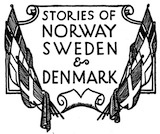Transcriber's Note:
The cover image was created by the transcriber and is placed in the public domain.
Transcriber's Note: Click on any image to view original scan.
This book is intended to encourage a friendly attitudetowards people of other lands. Fast steamers,airplanes, and the radio have made the people of alllands neighbors, and American boys and girls mustbecome better acquainted with their neighbors acrossthe seas if they are to understand and appreciatethem. Through material such as is given in Near theTop of the World, children may come to know interestingand likable people of another country, and toregard them as people like themselves, not as queeror amusing.
The author traveled widely in Scandinavia for thepurpose of gathering material. She watched the people,especially the children, at work and play. Shevisited homes, schools, libraries, farms, saeters, Lappsettlements. She talked with teachers, librarians, andother citizens of Norway, Sweden, and Denmark,and they assisted her generously in seeing and interpretinglife in their lands.
The pictures which illustrate the stories are photographs,some of them taken by the author. For otherpictures she is grateful to the American-SwedishNews Exchange, New York, the Norwegian GovernmentRailway, New York, and the Danish GovernmentRailway, New York.
The vocabulary is simple and although the bookwas written for no specific grade, the sentence structurehas been adapted to third grade reading. Thestories were tested in third grade classrooms and revisedto remove any difficulties that were encountered.The vocabulary was checked with the GatesWord List and the Thorndike Word List with thefollowing results: 74 per cent of the words in therandom sampling fall in the Gates 1500 list; 84 percent in Thorndike’s first 2000 list, 90 per cent inThorndike’s first 3000 list, and 94 per cent in Thorndike’sfirst 5000 list. Very few unusual words havebeen used.
The material has numerous possibilities for classroomuse:
The book will be of special service to teachers see

